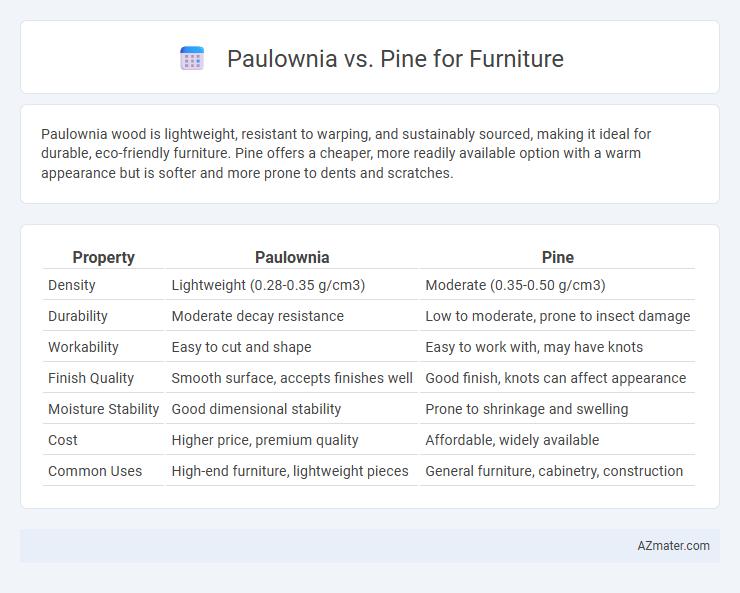Paulownia wood is lightweight, resistant to warping, and sustainably sourced, making it ideal for durable, eco-friendly furniture. Pine offers a cheaper, more readily available option with a warm appearance but is softer and more prone to dents and scratches.
Table of Comparison
| Property | Paulownia | Pine |
|---|---|---|
| Density | Lightweight (0.28-0.35 g/cm3) | Moderate (0.35-0.50 g/cm3) |
| Durability | Moderate decay resistance | Low to moderate, prone to insect damage |
| Workability | Easy to cut and shape | Easy to work with, may have knots |
| Finish Quality | Smooth surface, accepts finishes well | Good finish, knots can affect appearance |
| Moisture Stability | Good dimensional stability | Prone to shrinkage and swelling |
| Cost | Higher price, premium quality | Affordable, widely available |
| Common Uses | High-end furniture, lightweight pieces | General furniture, cabinetry, construction |
Introduction to Paulownia and Pine Wood
Paulownia wood, known for its exceptionally lightweight and fast-growing characteristics, offers excellent dimensional stability and resistance to warping, making it ideal for furniture that requires both durability and ease of handling. Pine wood features a softer texture with a more pronounced grain pattern, which provides a warm, rustic aesthetic commonly favored in traditional furniture designs. The choice between Paulownia and Pine for furniture hinges on balancing Paulownia's moisture resistance and weight advantages against Pine's affordability and classic appearance.
Physical Properties Comparison
Paulownia wood is significantly lighter and softer than pine, with a density of approximately 0.3-0.4 g/cm3 compared to pine's 0.5-0.7 g/cm3, making it easier to handle and ideal for lightweight furniture. While paulownia exhibits excellent resistance to warping and cracking due to its dimensional stability, pine offers greater hardness and durability, with a Janka hardness rating around 400-700 lbf versus paulownia's 150-350 lbf. Moisture content and drying times also differ; paulownia dries quickly and is less prone to shrinkage, whereas pine requires longer drying times and has a higher tendency to swell or shrink with humidity changes.
Weight and Density Differences
Paulownia wood is significantly lighter than pine, with a density typically around 260 kg/m3 compared to pine's average density of 500 kg/m3, making it ideal for lightweight furniture. The lower density of paulownia results in easier handling and transportation but reduces its durability compared to denser pine wood, which offers greater strength and resistance to dents and scratches. Weight differences make paulownia a preferred choice for portable and decorative furniture, while pine is favored for heavy-use pieces requiring robust structural integrity.
Workability and Ease of Crafting
Paulownia wood is highly favored in furniture making for its exceptional workability, being lightweight with a fine, even grain that allows easy cutting, sanding, and finishing. Pine, while also relatively easy to work with, is denser and has more prominent knots, which can complicate carving and sanding processes. The lower density of Paulownia reduces tool wear and handling effort, making it ideal for intricate designs and quick crafting compared to the more robust and slightly tougher Pine.
Durability and Lifespan
Paulownia wood offers exceptional durability with natural resistance to warping, cracking, and insect damage, making it ideal for lightweight yet long-lasting furniture. Pine furniture, while affordable and widely available, tends to be softer and more prone to dents, scratches, and decay over time, reducing its overall lifespan. The lifespan of Paulownia furniture can exceed several decades with proper care, outperforming pine which often requires more frequent maintenance and eventual replacement.
Appearance and Grain Patterns
Paulownia wood features a lighter, more uniform appearance with subtle, straight grain patterns that create a smooth, contemporary look ideal for modern furniture. Pine displays a warmer, golden hue with prominent knots and swirling grain, adding rustic charm and character to traditional or country-style furniture. The distinct grain contrast between Paulownia's fine texture and Pine's bold patterns influences design choices based on aesthetic preferences and desired furniture styles.
Cost and Availability
Paulownia wood is generally more expensive than pine due to its faster growth rate and lighter weight, yet it remains less widely available in markets compared to the abundant and affordable pine. Pine offers greater cost efficiency and easier sourcing, making it a popular choice for mass-produced and budget-friendly furniture. The limited supply and higher price of paulownia make it suitable for niche, lightweight, and high-end pieces where durability and unique grain patterns are prioritized.
Environmental Impact and Sustainability
Paulownia wood is highly renewable, growing up to 20 feet in its first year, which significantly reduces deforestation compared to slower-growing pine species. Pine forests often require more intensive management and longer harvest cycles, leading to greater environmental disruption and carbon emissions. The lightweight and fast-regenerating nature of paulownia also contribute to lower carbon footprints and sustainable furniture production practices.
Maintenance and Care Needs
Paulownia wood requires minimal maintenance due to its natural resistance to moisture and insects, making it ideal for low-care furniture. Pine, while affordable and widely available, demands more frequent sealing and protection against scratches and dents to maintain its appearance. Regular cleaning and occasional refinishing are essential for pine furniture to prevent wear and extend its lifespan.
Best Applications for Paulownia vs Pine
Paulownia is ideal for lightweight furniture and decorative pieces due to its fast growth, low density, and resistance to warping, making it suitable for portable or intricate designs. Pine, with its greater hardness and durability, excels in sturdy furniture such as tables, chairs, and cabinetry that require long-term strength and wear resistance. Choosing Paulownia benefits projects prioritizing sustainability and ease of handling, while Pine suits applications demanding robustness and traditional aesthetics.

Infographic: Paulownia vs Pine for Furniture
 azmater.com
azmater.com